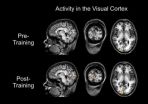Children with heart devices and their parents struggle with quality of life
American Heart Association Rapid Access Journal Report
2012-12-05
(Press-News.org) Children with implanted heart-rhythm devices and their parents suffer from a lower quality of life compared with their healthy counterparts and may benefit from psychotherapy according to new research in Circulation: Arrhythmia & Electrophysiology, an American Heart Association journal.
Researchers at the Cincinnati Children's Hospital Medical Center studied 173 children with either a pacemaker (40 patients) or implanted defibrillator (133 patients) to assess their quality of life compared to other children with congenital heart disease and to healthy children. The children, ages 8 to 18 years old, and their parents completed quality of life questionnaires.
Compared with healthy children and their parents, children with heart devices and their parents reported significantly lower quality of life scores. Likewise, their scores were also lower than those of children with mild congenital heart disease. However, their quality of life scores were similar to those for children with more severe heart disease but no device.
For children, self-perception, self-worth, and athletic capability affected quality of life.
For parents, their child's behavior was the biggest factor related to quality of life.
Also, children with an implantable defibrillator tended to have lower quality of life scores than those with pacemakers.
"These findings should encourage us to consider the negative impact of devices, particularly defibrillators, on pediatric patients; and to develop strategies to mitigate these effects," said Richard J. Czosek, M.D., study author and assistant professor of pediatrics at the Cincinnati Children's Hospital Medical Center, Heart Institute in Ohio. "Whether these effects on quality of life can be reduced through the use of psychotherapy needs to be assessed."
###
Co-authors are William J. Bonney, M.D.; Amy Cassedy Ph.D.; Douglas Y. Mah, M.D.; Ronn E. Tanel, M.D.; Jason R. Imundo, M.D.; Anoop K. Singh, M.D.; Mitchell I. Cohen, M.D., Christina Y. Miyake, M.D.; Kara Fawley, B.S.; and Bradley S. Marino, M.D.
Author disclosures and sources of funding are on the manuscript.
For the latest heart and stroke news, follow us on twitter: @HeartNews.
Statements and conclusions of study authors published in American Heart Association scientific journals are solely those of the study authors and do not necessarily reflect the association's policy or position. The association makes no representation or guarantee as to their accuracy or reliability. The association receives funding primarily from individuals; foundations and corporations (including pharmaceutical, device manufacturers and other companies) also make donations and fund specific association programs and events. The association has strict policies to prevent these relationships from influencing the science content. Revenues from pharmaceutical and device corporations are available at www.heart.org/corporatefunding.
ELSE PRESS RELEASES FROM THIS DATE:
Crag keeps the light 'fantastic' for photoreceptors
2012-12-05
HOUSTON – (Dec. 4, 2012) –The ability of the eye of a fruit fly (Drosophila melanogaster) to respond to light depends on a delicate ballet that keeps the supply of light sensors called rhodopsin constant as photoreceptors turn on and off in response to light exposures, said researchers from Baylor College of Medicine (www.bcm.edu) and the Jan and Dan Duncan Neurological Research Institute (http://www.nri.texaschildrens.org/) at Texas Children's Hospital in an article that appears online in the journal PLOS Biology (http://www.plosbiology.org/home.action).
The gene Crag ...
Learning to control brain activity improves visual sensitivity
2012-12-05
Training human volunteers to control their own brain activity in precise areas of the brain can enhance fundamental aspects of their visual sensitivity, according to a new study. This non-invasive 'neurofeedback' approach could one day be used to improve brain function in patients with abnormal patterns of activity, for example stroke patients.
Researchers at the Wellcome Trust Centre for Neuroimaging at UCL used non-invasive, real-time brain imaging that enabled participants to watch their own brain activity on a screen, a technique known as neurofeedback. During the ...
Semen concentration and quality fell in French men between 1989 and 2005
2012-12-05
New research shows that the concentration of sperm in men's semen has been in steady decline between 1989 and 2005 in France. In addition, there has been a decrease in the number of normally formed sperm. The study is published online today (Wednesday) in Europe's leading reproductive medicine journal Human Reproduction [1].
The study is important because, with over 26,600 men involved, it is probably the largest studied sample in the world and although the results cannot be extrapolated to other countries, it does support other studies from elsewhere that show similar ...
Put the kettle on? When tea drinkers were viewed as irresponsible as whiskey drinkers
2012-12-05
Poor women who drank tea were viewed as irresponsible as whisky drinkers in early 19th-century Ireland, new research by Durham University has unearthed.
Critics at the time declared that the practice of tea drinking – viewed as a harmless pastime in most past and present societies – was contributing to the stifling of Ireland's economic growth, and was clearly presented as reckless and uncontrollable.
Women who drank tea wasted their time and money, it was said, drawing them away from their duty to care for their husbands and home. It was felt this traditionally female ...
More babies survive premature birth, but serious health problems unchanged
2012-12-05
Research published on bmj.com today suggests that although more babies survived shortly after extreme preterm birth in England in 2006 compared with 1995, the number with major conditions on leaving hospital remained largely unchanged.
A second study, also published today, shows some improvement in the number of extremely preterm children who survived without disability at 3 years of age, but no change in the rate of serious health and developmental problems over the same 10-year period.
Taken together, these two large studies (known as the EPICure studies) suggest ...
Gaps in life expectancy between rich and poor set to increase over next 10 years
2012-12-05
Health inequalities between England's richest and poorest areas have widened in the ten years between 1999 and 2008. Researchers warn, in a study published today on bmj.com, that over the next ten years, we may experience smaller increases in life expectancy than in the past decade and health inequalities may rise at an even faster rate.
Studies have shown that economic decline is associated with long term negative health impacts and the current climate has raised concerns about this. Between 1999 and 2008 the target (set by the government) for reducing the gap in life ...
First measurements made of key brain links
2012-12-05
PROVIDENCE, R.I. [Brown University] — Inside the brains of mice and men alike, a relatively big football-shaped region called the thalamus acts like a switchboard, providing the prefrontal cortex, the part that does abstract thinking and decision-making, with most of its information. The thalamus's responsibility even includes helping the prefrontal cortex to maintain consciousness and arousal.
Essential as this "thalamocortical" partnership is, neuroscientists have understood very little about the connections coming from a matrix of cells in the so-called "nonspecific ...
Protected 'power naps' prove helpful for doctors in training to fight fatigue
2012-12-05
PHILADELPHIA – New research from the Perelman School of Medicine at the University of Pennsylvania and the Philadelphia VA Medical Center indicates that the implementation of protected sleep periods for residents who are assigned to overnight shifts in a hospital represent a viable tool in preventing fatigue and alleviating the physiological and behavioral effects of sleep deprivation among these doctors in training. The new results will be published in the December 5th edition of the Journal of the American Medical Association (JAMA).
"Within the last two years, we've ...
New evidence on how compound found in red wine can help prevent cancer
2012-12-05
University of Leicester scientists will present groundbreaking new evidence about how a chemical found in red wine can help prevent cancer on Wednesday, December 5.
Experts from around the world are set to attend Resveratrol 2012, a major conference at the University which will assess the latest advances in the study of resveratrol – a compound found in the skins of red grapes.
The conference will feature new findings based on the last two years of research, which show how the chemical can help prevent cancer, heart disease and diabetes.
The event follows the first ...
Scientists find oldest dinosaur – or closest relative yet
2012-12-05
Researchers have discovered what may be the earliest dinosaur, a creature the size of a Labrador retriever, but with a five foot-long tail, that walked the Earth about 10 million years before more familiar dinosaurs like the small, swift-footed Eoraptor and Herrerasaurus.
The findings mean that the dinosaur lineage appeared 10 million to 15 million years earlier than fossils previously showed, originating in the Middle Triassic rather than in the Late Triassic period.
"If the newly named Nyasasaurus parringtoni is not the earliest dinosaur, then it is the closest relative ...
LAST 30 PRESS RELEASES:
Injectable breast ‘implant’ offers alternative to traditional surgeries
Neuroscientists devise formulas to measure multilingualism
New prostate cancer trial seeks to reduce toxicity without sacrificing efficacy
Geometry shapes life
A CRISPR screen reveals many previously unrecognized genes required for brain development and a new neurodevelopmental disorder
Hot flush treatment has anti-breast cancer activity, study finds
Securing AI systems against growing cybersecurity threats
Longest observation of an active solar region
Why nail-biting, procrastination and other self-sabotaging behaviors are rooted in survival instincts
Regional variations in mechanical properties of porcine leptomeninges
Artificial empathy in therapy and healthcare: advancements in interpersonal interaction technologies
Why some brains switch gears more efficiently than others
UVA’s Jundong Li wins ICDM’S 2025 Tao Li Award for data mining, machine learning
UVA’s low-power, high-performance computer power player Mircea Stan earns National Academy of Inventors fellowship
Not playing by the rules: USU researcher explores filamentous algae dynamics in rivers
Do our body clocks influence our risk of dementia?
Anthropologists offer new evidence of bipedalism in long-debated fossil discovery
Safer receipt paper from wood
Dosage-sensitive genes suggest no whole-genome duplications in ancestral angiosperm
First ancient human herpesvirus genomes document their deep history with humans
Why Some Bacteria Survive Antibiotics and How to Stop Them - New study reveals that bacteria can survive antibiotic treatment through two fundamentally different “shutdown modes”
UCLA study links scar healing to dangerous placenta condition
CHANGE-seq-BE finds off-target changes in the genome from base editors
The Journal of Nuclear Medicine Ahead-of-Print Tip Sheet: January 2, 2026
Delayed or absent first dose of measles, mumps, and rubella vaccination
Trends in US preterm birth rates by household income and race and ethnicity
Study identifies potential biomarker linked to progression and brain inflammation in multiple sclerosis
Many mothers in Norway do not show up for postnatal check-ups
Researchers want to find out why quick clay is so unstable
Superradiant spins show teamwork at the quantum scale
[Press-News.org] Children with heart devices and their parents struggle with quality of lifeAmerican Heart Association Rapid Access Journal Report

